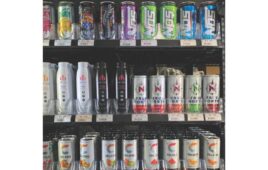 While it’s still an important category in convenience stores, the bubble has burst on gum sales over the past two years. The good news is manufacturers are doubling down on their efforts to grow the category with new products and better pricing.
While it’s still an important category in convenience stores, the bubble has burst on gum sales over the past two years. The good news is manufacturers are doubling down on their efforts to grow the category with new products and better pricing.
By Howard Riell, Associate Editor
Gum continues to prove something of an enigma for convenience store operators. While it remains a core segment within the candy category, sales have been slipping over the last few years, and not just a little.
Despite new flavor additions, American consumers simply aren’t chewing like they used to. After peaking five years ago, gum sales in the U.S. have dropped by 11% to $3.71 billion last year, according to Euromonitor International. Candy sales, at the same time, jumped 10%, to $31.53 billion.
Sales of gum and mints have slowed, in part, because they haven’t migrated over to functionality in the way that energy drinks and shots have, said Tom Pirko, managing director of BEVMARK, a consulting firm in Buellton, Calif.
“The opportunity for sales growth will come from ingredient claims,” Pirko said. “Energy gums and other functionality are what customers are looking for these days. It’s up to the manufacturers to deliver.”
But the answer isn’t that simple with gum insisted Tim Cote, vice president of the Beaverton, Ore.-based Plaid Pantries Inc., which operates more than 100 Plaid Pantry convenience stores. “The category tried to go upscale while not offering the consumer any real benefits for going upscale,” Cote said. “Maybe people don’t want a gum that lasts forever. Maybe people object to paying over $1.50 for a pack of gum.”
Cote also maintained that manufacturers have gotten into the habit of ignoring some of their core customers. “The gum companies abandoned the young gum consumer. I would guess that since the retail price points were low and flavor profile life cycles were short, it was not a very profitable segment of the business. Hubba Bubba, Bubble Yum, Bubbilicious, the entire novelty gum segment was either deleted or went to ignore status for years, so young people did not grow up chewing gum,” he said.
Over that last year, however, Wrigley has begun to address young chewers again. The company has revitalized Hubba Bubba with new flavors and a good flavor rotation. “This has been a good first step, but there is more to do,” Cote said. “Improved displays, better price promotions and good pricing are all vital for growing the category. Mondelez is having some success with Sour Patch gum, as well, but the price point is a little high to keep younger kids coming back. We are looking to drive repeat sales.”
Convincing gum chewers to pay more for gum may not be possible, Cote suggested. “Being a highly impulsive purchase, price point will always need to be on the low side,” he said.
Price and Functional Appeal
Star Stop Convenience Stores, with 68 locations in Austin and Houston, has maintained slow, steady gum sales with customers who have gravitated toward new products.
In two stores, the Texas chain is testing Desert Labs’ Snack Less chewing gum, the first in a new series of products powered by Hoodia parviflora. Hoodia has long been linked to appetite control, creating the same effect on the brain’s hunger regulating mechanism as eating a full meal, but without the calories.
Hoodia parviflora marks the first Hoodia product to gain ‘generally recognized as safe’ (GRAS) status by the U.S. Food and Drug Administration. Grown and marketed by Desert Labs, it provides consumers and supplement manufacturers access to the only safe Hoodia on the market. The Snack Less gum targets dieters looking to control their food cravings. Because the gum has only been on store shelves a couple of months, it’s too soon to tell if customers are sticking with the product or not.
But with 30% of gum chewers ages 18-34 and 33% of chewers 35 and older buying gum with the intention of consuming “fewer calories than other snacks,” the gum-as-appetite-suppressant innovation has the opportunity to meet a need. It does indicate gum manufacturers are
looking to add functional benefits to gum to increase the product’s appeal.
Mints manufacturers are also looking to boost sales with functional benefits. Miracle Mint, for example, boasts energy boosting, appetite curbing potential, as well as the ability to enhance focus and alertness.
An abundance of variety has also come back to bite the category, Cote suggested. “The explosion of mint flavors, for example, has diluted the message of any one mint being a good mint. I mean, how many ways can you say peppermint?”
In addition, too much impulse placement has been allocated to new items, ignoring the core and leading to core SKU erosion.
“Temporary displays have gotten fewer, and those that come out focus either on too many brands, or on flavors that need development rather than flavors that sell,” Cote said.
Contractual terms may also be working against gum.
“Overly SKU-intense rebate contracts have created retailer pushback, making gum a less-favored category to work with among retailers,” Cote said. “Due to mergers with other companies, most gum companies now have candy, cookies, crackers, etc. in their selling portfolios. Their own marketing departments and sales teams have divided their attention between too many categories, and via contract require retailers to do the same.”
Pricing remains another factor working against strengthening the category, which can reach $2 or more for a pack, Cote said.
“After years of telling us it wasn’t, gum manufacturers need to learn forever more that gum is retail price sensitive, and can be driven via price promotion,” he said. “In order to get gum sales back on track retailers need to help gum manufacturers understand how they can serve their retailer partners and end users—chewers—more effectively.”
Looking Ahead
Bringing sales back up may prove a lingering problem, and not one that retailers can solve on their own.
“This is not really a c-store issue other than the fact that c-stores need to make sure their product mix is up to date,” Cote said. “All channels are losing chewers. This is a category issue that needs manufacturers to lead the way back to better sales.”
The message, Cote added, is getting through. “I think by and large the gum manufacturers are hearing the right things from retail. They listen, but it is always hard to get a manufacturer to give up space in a set—and with current trends toward lower sales, that is a likely outcome.”
Manufacturers are trying to goose sales via marketing. Trident for example, which has seen sales dip more than 15% in developed markets, is running a new online campaign aimed at the younger generation.
Mentos is hoping that a clever $10-million television campaign that recalls the cult classic “Monty Python and the Holy Grail” will tickle consumers enough to spark sales of the pellet-gum brand, Mentos Pure Fresh Gum.
“The revival of gum and mints will come with a wave of new and innovative products that showcase stimulation, health-and-wellness aspects, and relative value,” Pirko said. “This is an evolving category to which convenience stores should stay attuned. First-in will give them a competitive advantage.”




